#manuel ii of portugal
Text









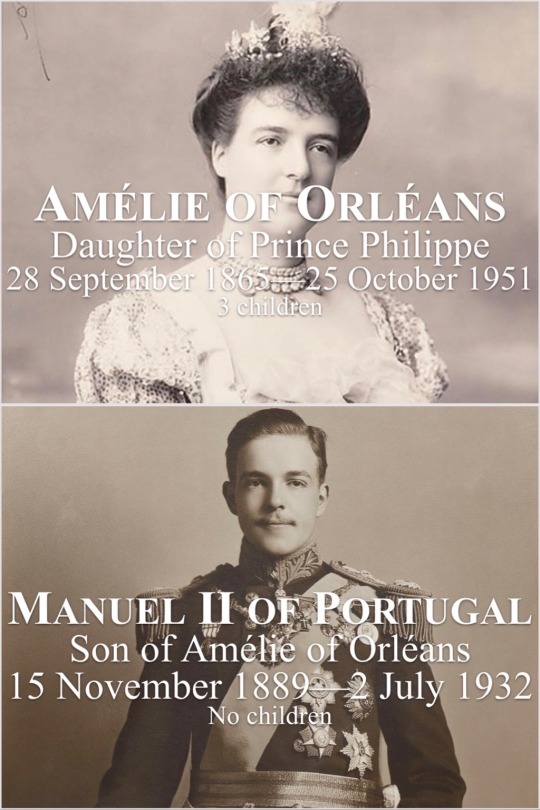
Descendants of the Tudors
#descendants of the tudors#henry vii#margaret tudor#james v#mary queen of scots#james vi and i#elizabeth stuart#charles i louis#elizabeth charlotte madame palatine#philippe ii duke of orléans#charlotte aglaé d’orléans#maria teresa felicitas d’este#louise marie adélaïde de bourbon#louis philippe i#ferdinand philippe duke of orléans#prince philippe#amélie oforléans#manuel ii of portugal
2 notes
·
View notes
Text

Nine European Sovereigns at Windsor Castle for the funeral of King Edward VII of the United Kingdom (Photo courtesy of Royal Collection Trust) | May 20, 1910
Standing (left to right): King Haakon VII of Norway, King Ferdinand of Bulgaria, King Manuel of Portugal, Emperor William II of Germany, King George I of the Hellenes, King Albert of the Belgians
Seated (left to right): King Alfonso XIII of Spain, King George V, King Frederick VIII of Denmark
#royaltyedit#theroyalsandi#george v#king george v#king george v of the united kingdom#haakon vii of norway#king ferdinand of bulgaria#king manuel of portugal#king william ii of germany#king george of hellenes#king albert of the belgians#king alfonso xiii of sapin#king frederick viii of denmark#british royal family#my edit
77 notes
·
View notes
Text

D. Manuel II de Portugal
22 notes
·
View notes
Text

Manuel Maria Filipe Carlos Amélio Luís Miguel Rafael Gabriel Gonzaga Xavier Francisco de Assis Eugénio, King Manuel II of Portugal
British vintage postcard
#vintage#tarjeta#francisco#maria#xavier#briefkaart#manuel maria filipe carlos amélio luís miguel rafael gabriel gonzaga xavier francisco de assis eugénio#amlio#postcard#photography#gonzaga#assis#postal#gabriel#carte postale#filipe#sepia#eugnio#ephemera#portugal#historic#british#manuel ii#carlos#king#ansichtskarte#postkarte#rafael#manuel#postkaart
7 notes
·
View notes
Text

Manuel II, King of Portugal, in Paris with Alfonso XIII, King of Spain, the two youngest sovereigns in Europe, front cover illustration from 'Le Petit Parisien', supplemnet litteraire illustre, 5th December 1909 (photolitho)
French School
#dianthus#carnation#portrait#1900s art#1900s fashion#Manuel II#King of Portugal#Alfonso XIII#King of Spain
3 notes
·
View notes
Text
youtube
𝘐𝘴𝘢𝘣𝘦𝘭𝘭𝘢 𝘰𝘧 𝘊𝘢𝘴𝘵𝘪𝘭𝘦, 𝘍𝘦𝘳𝘥𝘪𝘯𝘢𝘯𝘥 𝘰𝘧 𝘈𝘳𝘢𝘨𝘰𝘯, 𝘵𝘩𝘦𝘪𝘳 𝘤𝘩𝘪𝘭𝘥𝘳𝘦𝘯 + 𝘵𝘩𝘦𝘪𝘳 𝘭𝘰𝘷𝘦𝘴
#isabella of castile#ferdinand ii of aragon#Isabel#Isabella of aragon#joanna the mad#joanna of castile#philip the handsome#catherine of aragon#henry viii#John of aragon#Maria of aragon#Manuel i of portugal#Michelle Jenner#Catalina de Aragon#Youtube
1 note
·
View note
Text
People focus way too much on whether Katherine of Aragon and Arthur consummated the marriage, on whether she lied or not. The dispensation for HVIII and KoA’s marriage covered both possibilities, and it was neither the first nor the last marriage of this kind (Manuel I of Portugal married two sisters and their niece, Sigismund II of Poland married two sisters as well), Henry himself wanted to divorce his wife to marry the sister of his mistress and asked for a dispensation that would cover it.
36 notes
·
View notes
Text
My thoughts on this painting

I found it on twitter account called Tudor Extra, and they say it has been recently discovered by Dr Emma Cahill Marrón(on twitter as EmmaLCahill) in London.(link is at end of post)
Honestly in closeup it looks in really poor state.
On left are obviously Henry's parents and correctly identified so.
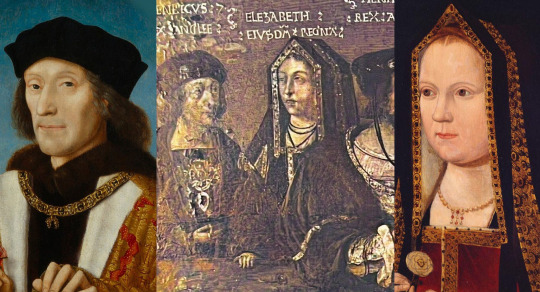
But i am not so sure about rest of figures being correctly identified. Or rather I am sure they aren't!
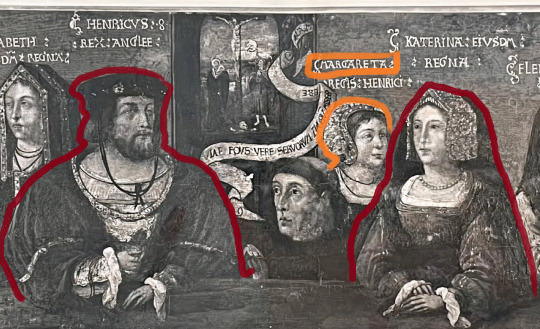
Yes, the figures lined in red are Henry VIII and Catherine of Aragon.
But the orange I lined in orange is supposed to be Margaret Tudor. Henry VIII's sister. Fashion-wise it's possible.
Catherine's gable hood has both veils down, frontlets up. So at earliest it could be somewhere in 2nd half of 1510s, at latest late 1520s. The lack of ends of paste would point to c.1520(however if this was a copy...painters tend to not include them, or not give them justice...) So I am not 100% trusting it.
Margaret left England in 1517(read up on her life, if you want to know more), so in theory she could have been included here. But why is she by Catherine's side? Or rather behind that. Odd isn't it?
Such possition would much better fit Mary I. The sizes can be deceiving here...because in reality Catherine is supposed to be way smaller than Henry...
Hence this figure doesn't necessarily have to be a child(Mary I), but could be. And Mary was wearing same cap in Vyne chapel(where is commonly mistaken for her mother.)
(If there was Margaret, why wouldn't there also be Mary Rose? (Henry's other sister). ...Wouldn't that be even more odd than his daughter being included.)
But...I am really buffled by two figures entirely on right side.
Allegedly on left is Eleanor of Austria and on right her husband Manuel I of Portugal, whom she married in 1518:

...Nobody thinks it weird? ...Just me?
Well, in my opinion. They are misidentified. Both of them.
The man wears order of golden fleece-but that wasn't limited to just Habsburgs, plenty of foreign royalty were honourary members. Including Manuel of Portugal and Ferdinand II of Aragon.
One would be normally considering if the entire portrait is not done to commemorate Charles V visit to England...with figure beside him being widowed Germaine of Foix(who was there!).
But why would Henry's parents be included in such portrait?...Makes no sense!
Unless...we're looking at dynastic portrait!!!
...Where Henry's parents are on left, Henry, Catherine and their daughter Mary in middle, and Catherine's parents on right!
This could certainly be Ferdinand:
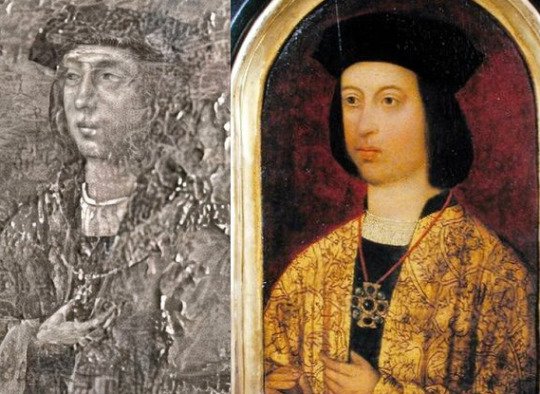
Ferdinand died in 1516, but Henry's parents were long dead too...
But...what about the woman? You cannot tell firmly the shape of gown and jewelry(mind could easily play tricks upon you.)

But why would Isabella wear french hood?
...And i considered that perhaps somebody confused portrait of Germaine of Foix or even real Eleanor and Joanna(netherlandish type of frenhc hood) with Isabella...
But then I noticed shape within the french hood's veil...
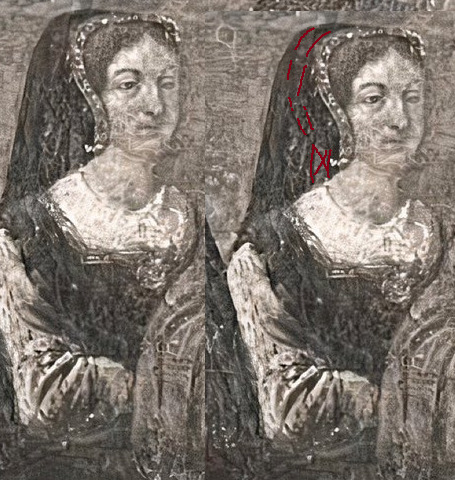
And it looks suspiciously like cofia de tranzado... the cap and 'braid', just where they are supposed to be.The headwear is overpainted!
Hence it could be based upon some portrait of Queen Isabella!
Unfortunately this is just card/print from Ancaster Collection, Grimstorpe castle labelled slightly wrong as family of Henry VII(instead of Henry VIII):
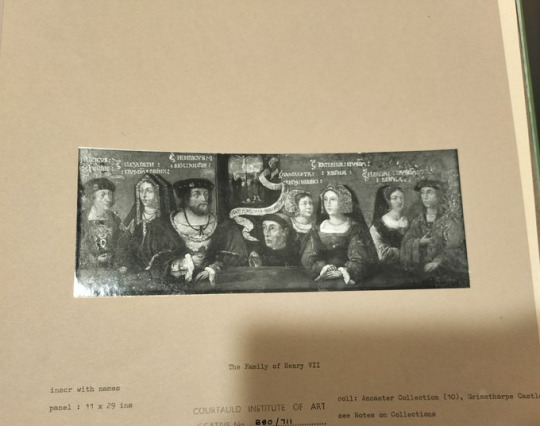
I hope we can all agree. It deserves way more love and attention.
This might be the first Tudor dynastic portrait!
Equivalent of Whitehall Mural or The family portrait from 1542/3.
...And if there is black and white card of it...is it drawing, engraving, printm or photograph? ...It could be out there...
PS: In it...Elizabeth of York is taller than Henry VII. Not that I'd trust the proportions entirely...but it'd be funny if true.
#historical portraits#tudor history#catherine of aragon#mary i of england#henry vii of england#elizabeth of york#mistaken identity
29 notes
·
View notes
Text








AU: Valois House. Children Francis I and Claude Valois.
Luisa(1515 - 1576). Queen of Spain and Empress of the Holy Roman Empire. Wife of Charles V. Despite the fact that the age difference between the spouses was 16 years, they loved each other. Charles treated his young wife with tenderness. She was interested in music, dancing and writing. Luisa and Charles had 7 children: John III, Claude, Philip, Ramiro, Ferdinand, Joana, Charles.
Charlotte(1516 - 1570). Queen of Portugal. Wife of Juan III and mother of 6 children: José I, Manuel, Isabella, Sancho, Aldegunda, Mary. Charlotte devoted much time to the education of her children and the enlightenment of the Portuguese court. She was the favorite sister of Francis II and maintained a close relationship with his wife.
Francis II(1518 - 1590). King of France. Husband of Mary Tudor. Francis loved his wife. Unlike his father and brothers, he never had mistresses or children out of wedlock. The reign of Francis II was an era of prosperity and rise. Father of 8 children: Claude, Francis III, Catherine, Charlotte, Tristan, Raoul, Adele, Henry.
Henry(1519 - 1587). Duke of Orleans. Husband of Catherine de Medici and father of 10 children: Francis, Elizabeth, Claude, Louis, Charles, Henry, Margaret, Hercule, Victoria and Jeanne. All his life loved only his mistress Diana de Poitiers, even wanted to marry her, but because of pressure from his father did not do it.
AU: дом Валуа. Дети Франциска I и Клод Валуа.
Луиза(1515 - 1576). Королева Испании и императрица Священной римской империи. Жена Карла V. Несмотря на то, что разница в возрасте между супругами была 16 лет, они любили друг друга. Карл с нежностью относился к молодой жене. Интересовалась музыкой, танцами и писательством. У Луизы и Карла родилось 7 детей: Хуан III, Клод, Филипп, Рамиро, Фердинанд, Хуана, Карл.
Шарлотта(1516 - 1570). Королева Португалии. Жена Жуана III и мать 6 детей: Жозе I, Мануэль, Изабелла, Саншу, Альдегунда, Мария. Шарлотта уделяла много времени образованию своих детей и просвящению Португальского двора. Была любимой сестрой Франциска II и поддерживала близкие отношения с его женой.
Франциск II(1518 - 1590). Король Франции. Муж Марии Тюдор. Франциск любил свою жену. В отличие от отца и братьев у него никогда не было любовниц и внебрачных детей. Правление Франциска II было эпохой процветания и подъёма. Отец 8 детей: Клод, Франциск III, Екатерина, Шарлотта, Тристан, Рауль, Адель, Генрих.
Генрих(1519 - 1587). Герцог Орлеанский. Муж Екатерины Медичи и отец 10 детей: Франциск, Елизавета, Клод, Людовик, Карл, Генрих, Маргарита, Эркюль, Виктория и Жанна. Всю жизнь любил только свою любовницу Диану де Пуатье, даже хотел на ней жениться, но из-за давления отца не стал этого делать.
Part 1.
#history#history au#royal family#royalty#au#france#france history#History of France#French royal family#french#french royalty#french royal family#French royal#Royal#Royals#the tudors#henryviii#mary tudor#the serpent queen#catherine de medici#mary stuart#Henryii#francis valois#The reign#elizabeth i#15th century#16th century#Francis i#Francisii#French kings
23 notes
·
View notes
Text
#JON SNOW FORTNIGHT EVENT 2023
@asoiafcanonjonsnow
DAY 10: ECHOES OF THE PAST 🗝️📜(2/2) ->
Historical parallels with Medieval bastard Kings.
John I of Portugal
To complete the the previous post of this meta, we're going to dive in the parallels and simmilarities between Jon Snow and John I of Portugal through the following points:
BASTARDY
John I of Portugal also known as John of Avis, was the bastard son of King Peter I of Portugal and Teresa Guille Lourenço, a Galician noblewoman, lady in waiting of Inês de Castro, or according to other sources, the daughter of some Lisbon merchants.
Jon Snow is officially known to be Ned Stark's bastard son, and if we consider R+L=J, he's Prince Rhaegar and Lyanna's son, and as far as we know Jon is still a bastard.
PARENT'S TRAGIC LOVE STORY
John I's father, Peter I of Portugal fell in love with Inês, a lady in waiting and cousin of Constanza Manuel de Villena (Peter's wife).
After Constanza died, they became lovers and they had four children and they wed in secret, but some Portuguese nobles and Peter's father, Afonso IV of Portugal, disliked their relationship because the possible influences of Inês' family. They plotted to kill her, Inés was killed by three of those men and it's said that when Peter became king, he put Inês' corpse in a throne next to him so that the people would swear allegiance to her as queen of Portugal and looked for revenge chasing the ones who killed Inês. John I was born a few years after Inês died when Peter I had an affair with Teresa Lourenço.
Jon's parents, Rhaegar and Lyanna met at the Harrenhal Tourney, in which both participated, Lyanna as the Knight of the Laughing Tree, Aerys sent Rhaegar some men to learn the identity of the mystery knight, so it's likely that Rhaegar figure it out and then crowned her as Queen of Love and Beauty when he won the tourney. They fell in love and run away together, Rhaegar died at the Battle of the Trident during Robert's rebellion and Lyanna died after giving birth to Jon at the Tower of Joy.
BROTHER IS THE KING
After Peter I of Portugal died, he was succeeded by his son with Constanza Manuel de Villena, Ferdinand I, and John held a prominent position during the reign of his brother.
Jon is a brother of the Night's Watch when Robb is proclaimed as King in the North and during his brief reign.
Apart from that it would be argued that Aegon VI fits here too because he's Jon's brother, but Young Griff's identity as Aegon VI is doubtful and he hasn't taken control of Westeros yet.
MILITAR EDUCATION AND CAREER
John was educated by Nuno Freire de Andrade, Master of the Order of Christ, and John became Master of the Order of Avís, one of the most important Orders in Portugal during the Middle Ages, from which he will take his last name.
Jon joined the Night's Watch, which can also be considered a militar order in which chastity is also imposed on its members just like the Order of Avis. Jeor Mormont, Lord Commander of the Night's Watch has been one of Jon's mentors, so just like John, Jon had the leader of a militar order as a mentor, and then became the head of a militar order.
RELATIONSHIPS/LOVE INTERESTS
While John formed part of the Order of Avis, despite vows of chastity, John had two bastard children with Inês Pires when he was a teenager, Beatrice and Afonso, 1st Duke of Braganza.
Jon broke his vows by falling in love and being with Ygritte, even though Jon didn't had children with Ygritte, and Jon has also expressed that he didn't want to have them because of the stigma of being a bastard and the classist Westerosi society.
POLITICAL MATCH MAKER
John was one of the negotiators of the successive marriage projects of his niece and the heiress Beatrice of Portugal, who would end up marrying John I of Castile (Henry II of Castile's son), as a way to seal peace after the Fernandine Wars, in which Ferdinand I tried to overthrow Henry II from the Castilian throne, who became king after killing his legitimate brother Peter I of Castile (who was Ferdinand I's cousin), and was supported by one of Peter I's legitimised bastard children, Constance of Castile.
In the agreements established that each one would independently reign their kingdoms and the offspring of both would inherit Portugal, although if Beatrice died without children, the heirs of her husband would inherit Portugal, and John I of Castile has children from a previous marriage to Eleanor of Aragon (this is important detail for later).
Jon has also arranged a wedding of a familiar during his time as head of the militar institucional, as the Karstarks originated as a cadet branch of the Starks, and there have been intermarriages between the two houses, so we could assume Alys and Jon are distant cousins, such as Alys and Sigorn's wedding.
PROBLEMS OF SUCESSION AND INDEPENDENCE OF THEIR KINGDOMS & THEIR RISE TO KINGSHIP
After the death of Ferdinand I, a succession crisis took place in Portugal between Beatrice, who had no offspring, and the children of Peter I of Portugal with Inés de Castro (who were considered bastards by the Portuguese nobility), and also John revolted at end of 1384 with the support of the commonfolk and the bourgeoisie, and promoted a war to maintain the independence of Portugal, adopting the title of defender of the kingdom, which he achieved by defeating Beatrice and John I of Castile, for which he was crowned king of Portugal, being the first king and founder of the House of Avis.
Due to what happened to John with the fight for the independence of Portugal against another family member, it is most likely that in TWOW when Jon arrives in Winterfell the inheritance problem between the Starklings will have to be solved, and with Robb's will and his position as the older brother and being the one with political experience, supported by the Free Folk, the Mountain Clans and some Northern Noble Houses like the recently created House of Thenn, formed by Alys and Sigorn, Jon will be named king in the North breaking relations with the Iron Throne that is under the control of the Lannisters and the North will be (for the moment) independent again. In addition, the matter of Beatrice and her husband John I of Castile reminds me a bit of the marriage of Sansa and Tyrion, being Tywin's initial plan to get the North under the rule of the Lannisters, although that did not work and the best method was having the Boltons at Winterfell. Plus both Tyrion and John I of Castile have lions in their sigils, although the Castilian lion is purple (or in some media, red) and the Lannister one is golden.
ALLIANCES, MARRIAGE & OFFSPRING/POSSIBLE MARRIAGE (SPECULATIONS)
Like his brother Ferdinand I, John supported Constance's cause, allying with her against John I of Castile, but they were defeated and Constance did not get the Castilian throne, her daughter Catherine of Lancaster married John I of Castile's son, Henry III, and their son was John II of Castile, thus uniting the two lines of succession of Alfonso XI of Castile.
As well as Peter I of Castile's two eldest surviving daughters married two of Edward III of England's sons (Constance married John of Gaunt, 1st Duke of Lancaster and Isabella married Edmund of Langley, 1st Duke of York), John I of Portugal married Philippa of Lancaster, John of Gaunt's eldest daughter with Blanche of Lancaster, and they had a loving marriage and eight children: Blanche, Afonso, Edward I of Portugal, Peter, Henry, Isabella, John and Ferdinand.
Edward was a poet and writer, his more important books were, on good governance,'The Loyal Counselor', 'Book of Councils', 'Response, being princes, to the infant D. Ferdinand about some complaints he had of his father'; on sports and horsemanship, with educational connotations, 'Teaching book about riding well in any saddle' and "Regiment to learn to play weapons'.
It's very likely that Jon will need to make more alliances to stablish his position as King in The North and preparing for the War for the Dawn and fight against the Others, and one way to do it it would be marrying someone with a prominent influence and a big army.
And although Dany hasn't landed on Westeros yet, due to her army and her influence as queen claimant to the Iron Throne, could be a good ally, and Dany would like to help due to her care for people who are needed, so probably Jon and Dany would join forces and eventually they could fall in love, marry and rule Westeros together.
Plus, if Jon ans Dany have children, one of them could be a poet like Edward I or a music composer and a bookworm like Rhaegar.
CUNNING/KNOWLEDGE
Contemporary writers state John that his position as a master of a religious military order made him an exceptionally learned king for the Middle Ages. His love for knowledge and culture was passed down to his children, who are collectively referred to by Portuguese historians as the illustrious generation, for example, Edward I the Eloquent and Peter were considered as two of the most learned princes of their time, and Henry the Sailor invested heavily in science and in the development of nautical activities.
Although Jon is often seen as a warrior, he has shown interest on knowledge and books too and he has been showing competences and skills for being a good leader and he's cunning good at politics and a good administrator, as he has been proving during his time as Lord Commander of the Night's Watch.
DRAGON IMAGERY
John I of Portugal's sigil has some elements that make me link him with Jon, his emblem has a crest with a dragon, which was usually used in the heraldry of the Portuguese Royal family, in which a dragon appears in the Royal crest or two green dragons as the supports of coat of arms, which makes me think of Rhaegal, a green dragon, who was named after Rhaegar and most likely Jon is its dragonrider.
#jonsnowfortnightevent2023#jonsnowfortnightevent#jon snow#meta#canonjonsnow#canonjon#jon meta#asoiaf meta#day 10#echoes of the past#historical parallels#john i of portugal#João I#medieval bastard kings
31 notes
·
View notes
Text

Le "Real Gabinete Português de Leitura" est une bibliothèque du centre de Rio de Janeiro, au Brésil. Ce temple de la lecture possède la plus grande collection de littérature portugaise en dehors du Portugal. L'institution a été fondée en 1837 par quarante-trois immigrants portugais réfugiés politiques, afin de promouvoir la culture au sein de l'empire du Brésil. Le bâtiment, conçu par l'architecte portugais Rafael da Silva e Castro, a été érigé entre 1880 et 1887 dans un style néo-manuélin. Ce style architectural évoque le style gothique-Renaissance exubérant en vigueur à l'époque des découvertes portugaises, nommé manuélin au Portugal pour avoir coïncidé avec le règne du roi Manuel (1495-1521). L'empereur Pedro II (1831-1889) a posé la première pierre de l'édifice le 10 juin 1880, et sa fille, Isabel, princesse impériale du Brésil, ainsi que son mari, le prince Gaston, comte d'Eu, l'ont inauguré le 10 septembre 1887.
29 notes
·
View notes
Text

Nevada Stoody Hayes (21 October 1870 – 11 January 1941), sometimes called Nevada of Braganza, was an American socialite who became the wife of Infante Afonso of Braganza, Duke of Porto, whose nephew, Manuel II, was the last king of Portugal.
4 notes
·
View notes
Text

The Nine Sovereigns at Windsor for the funeral of King Edward VII.
Photo taken in 1910.
Standing, from left to right: King Haakon VII of Norway, Tsar Ferdinand of Bulgaria, King Manuel II of Portugal, Kaiser Wilhelm II of the German Empire, King George I of Greece and King Albert I of Belgium.
Seated, from left to right: King Alfonso XIII of Spain, King-Emperor George V of the United Kingdom and King Frederick VIII of Denmark. This is probably the only photograph of nine reigning kings ever taken.
4 notes
·
View notes
Note
How about CURSED portuguese history facts?
Holy shit I don't know who sent me this but it accidentally got burried under mounds of under asks and I think it's been sitting in my inbox for a year
I feel fully armed for a few cursed facts now given my job lmfao
Here we go
1. The Ginjinha of Lisbon (OF LISBON, not Óbidos) was initially created as a cough medicine. Recomended dose? 6 glasses a day. Ginjinha has around 23% of alcohol. Yeah that sure straightened you up really well (if you look at the posters they have on both doors, the door to the left actually says the recomended dose)
2. During World War II, Lisbon received thousands of jewish refugees. Despite the war, the fact remained that these people came from, compared to our backwards provincial country, progressive places. Do you know what the most shocking thing for lisboners were? Jewish women (who, again, were pretty progressive in comparison) were seen... At cafés. Hordes of men would actually gather around these women who were dead ass just having lunch at a café because portuguese women did not go to cafés alone, as it was considered indicent and a place jsut for men. This was between 1932-1945. There’s a super interesting account of a rare case of a Jewish family that actually stayed here, and the lady describes how she went out for lunch with her mother. Suddenly, the daughter says to her mother “I think we’re starting a revolution” and she turns and sees a row of men just fucking staring at them with their jaws on the floor (source: Lisboa Judaica the book, forgot the name of the author, but it’s Francisco something).
3. Praça do Municipio is where City Hall is located. It’s a late neo-classical building that, when it was unveiled, caused a huge scandal. If you look up at the building's pediment, you will see a bas-relief with several human figures. At the centre, there is a man with his whole dick out. Which, hey, that’s standard in classical imagery, the whole nudity standing for perfection if you follow the Roman canon of art and etc. But ah, my friend, this is Portugal in the 19th century, and my God, were we a backwards country, so this is exactly what generated a HUGE scandal. You see, the problem was WOMEN. They could not possibly see this dick. So, women were forced to cover their eyes when they crossed that square. It became such a scandalous thing, one guy actually set up stand selling fans and veils for women so they could cover their eyes and cross the square without having to look at this dude's genitals. Mind you, they're hard to spot. Rafael Bordalo Pinheiro did a caricature of the event. I can't find it online but I saw it in the book I am about to give you as a source: Lisboa Desconhecida e Insólita, by Anísio Franco.
4. John VI used to hide chicken legs inside his pockets out of fear of being poisoned. He died of poison.
5. Legend says when the statue of José I was unveiled, the one in Praça do Comércio, the queen allegedly said "he looks so ugly". Allegedly, that is why he is wearing a helmet. Yes, the sculptor did nothing about the ugliness, just sort of tried to disguise it. Reminding you that this is a legend. As far as I am aware, the statue was always made with the helmet, but I honestly prefer this version, so that’s the one I tell on my tours lmfao
6. In the 16th century, Manuel I loved collecting animals he knew nothing about, and then gift them to the Pope. We know about the rhinoceros already, which ended up being painted by Dürer, but did you know he also got an elephant? One day, though, he decided it would be a great ideal to have the rhinoceros and the elephant fight each other. He set up an arena in Praça do Comércio. People went buckwild for this. It was like WWE for them. And when the two animals confronted each other.... Nothing happened. Turns out elephants are not really made to fight and the two animals didn't really give a shit about each other. However, elephants are easily spooked, and with a sudden movement from the rhinoceros, that's what happened. The elephant took off from the arena and ran across the entire city back to his caretaker.... And miraculously, did not stomp a single person. The Rhinoceros was declared a winner but only because the elephant quit. People were a little disappointed at this, and ironically enough, it’s the elephant that’s reminded (he had a name but I forgot). Source: another ANísio Franco book, called something like Passeios por Lisboa, I forgot I’m sorry.
7. When the French invaded our country, they found John II's tomb... And beheaded him. No real reason, I guess. The body was put back together and properly buried again by some nuns who kind of felt bad about it.
8. This one is not funny at all. But I'll say this: don't ever look into the Braganza's involvement in slavery if you want to preserve your sanity. It's some of the most horrid shit you'll come across.
EDIT: a while ago I mentioned this in another context, and someone asked for a source. I remember now I said I needed to look it up but, as ever, I forgot. With all my due apologies, here it is: https://expresso.pt/sociedade/2015-12-08-O-segredo-dos-escravos-reprodutores
9. The Marquis of Pombal once stole the waters of Sintra, leaving the people with ONE public fountain in butt fuck nowhere. I've talked about this one on here before but it shows how fucking insane the man was.
10. The expression "ficar a ver navios", which means "to stand by watching the ships pass", is used when someone is waiting for something that will not happen (like, if someone is stood up on a date, you say they stayed there watching the ships pass). It actually comes from the expulsion of the jews in 1497. Manuel I promised jewish people who wished to leave ships to board and go to North Africa. However, he also knew, because he was a fucking idiot but not entirely stupid, that if he expelled the jews, the country's economy would basically collapse, because jewish people held a GREAT number of businesses in not just Lisbon, but major metropolitan centres. So, this was a lie. The ships he promised never came. For months, jewish people went to the Santa Catarina hill every day to look out for ships that would let them board and leave the country. The ships never came, thus, they were "watching the ships pass", but none of them stopping.
Okay this is all I can think of A YEAR LATER LOL
68 notes
·
View notes
Text
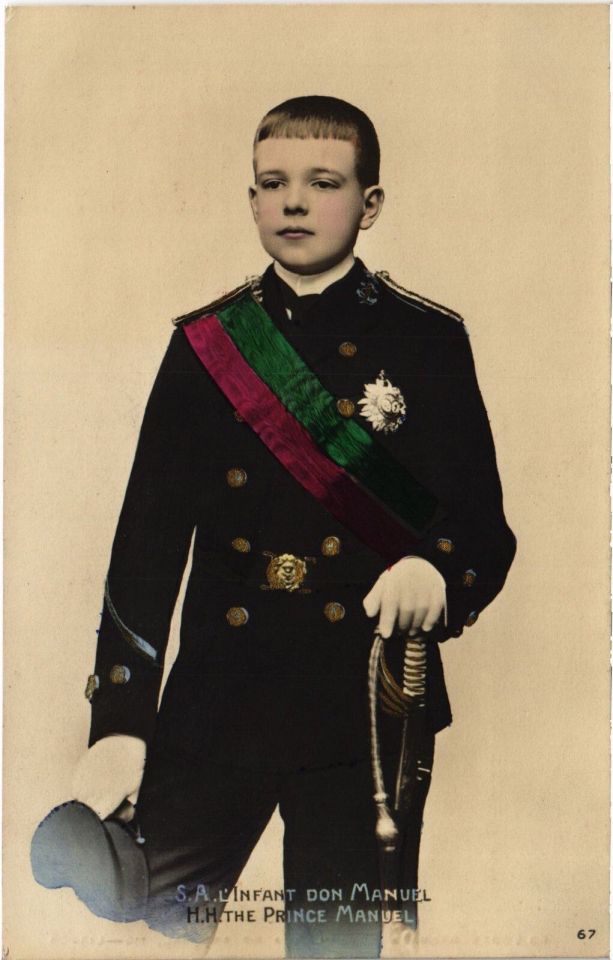
Prince Manuel Maria Filipe Carlos Amélio Luís Miguel Rafael Gabriel Gonzaga Xavier Francisco de Assis Eugénio of Bragaza, later King Manuel II of Portugal
Portuguese vintage postcard
#historic#briefkaart#maria#postkaart#carte postale#manuel#ephemera#xavier#miguel#francisco#tarjeta#photo#filipe#postcard#postal#portuguese#amlio#postkarte#assis#manuel ii#prince#later#king#ansichtskarte#rafael#bragaza#carlos#portugal#gonzaga#gabriel
5 notes
·
View notes
Text
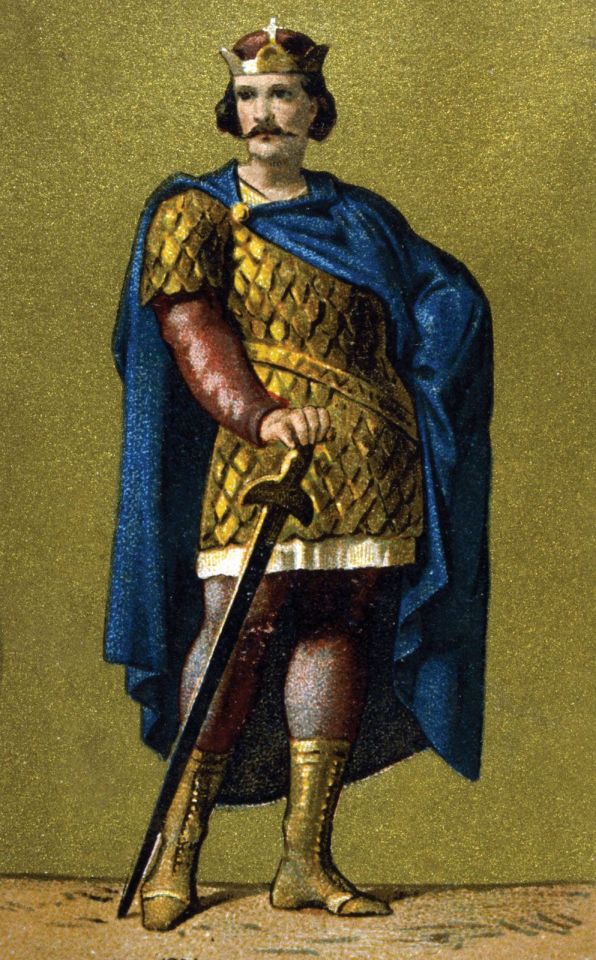
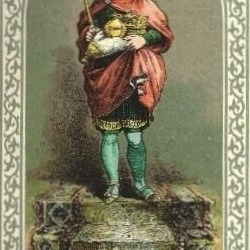



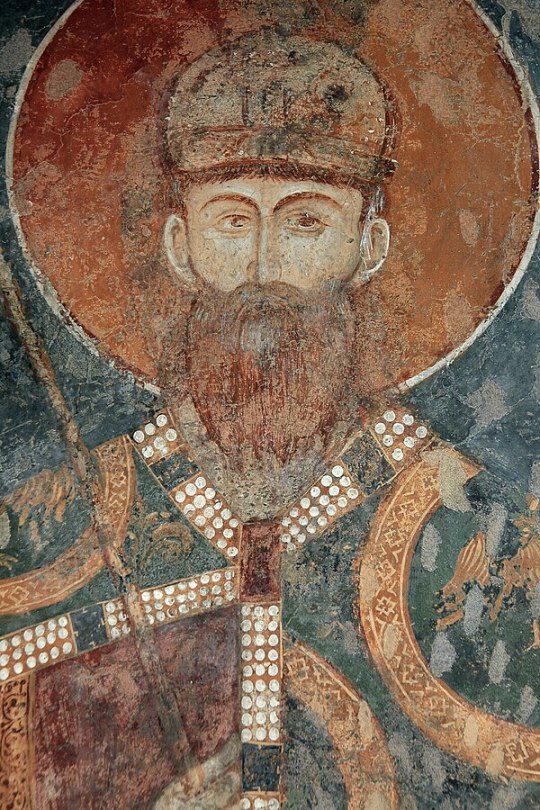
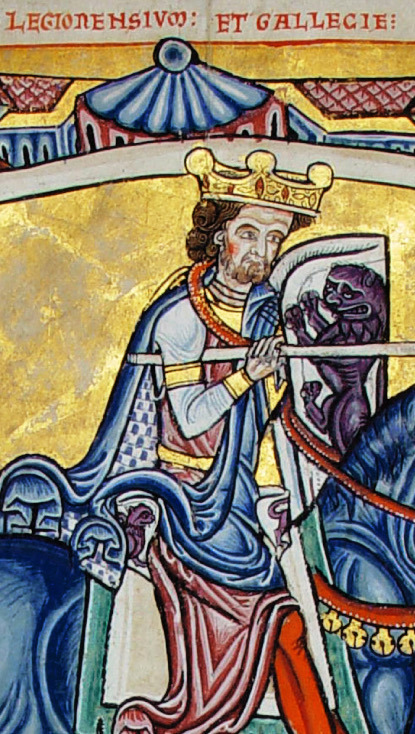
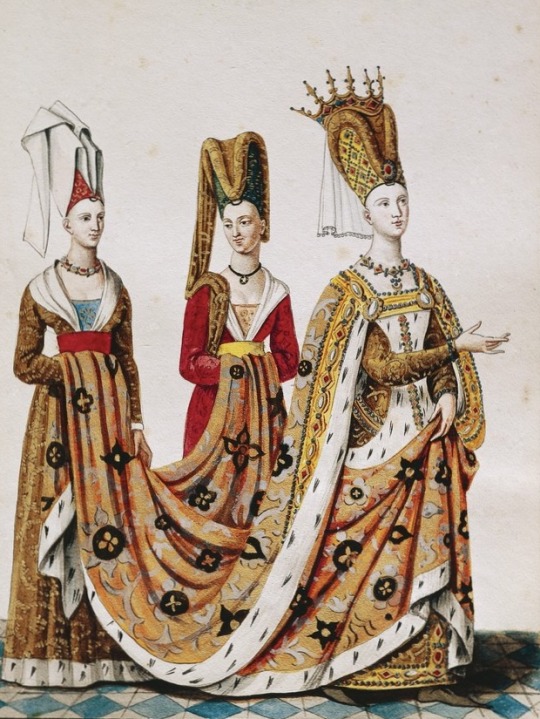
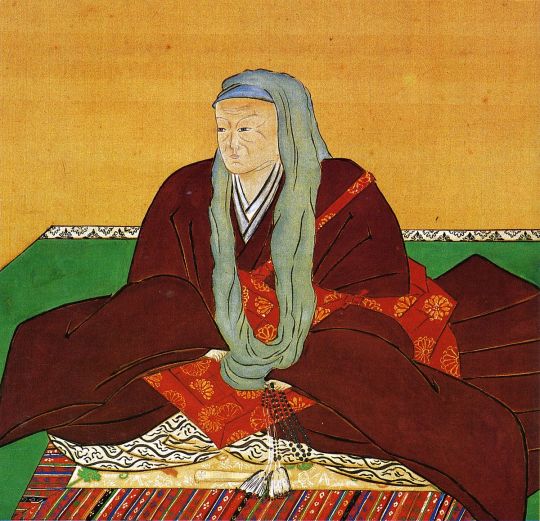
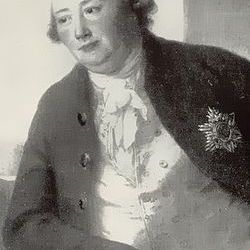
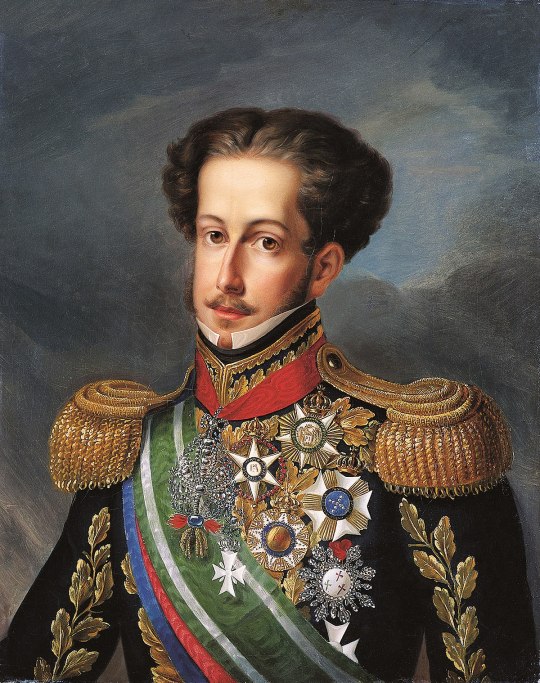
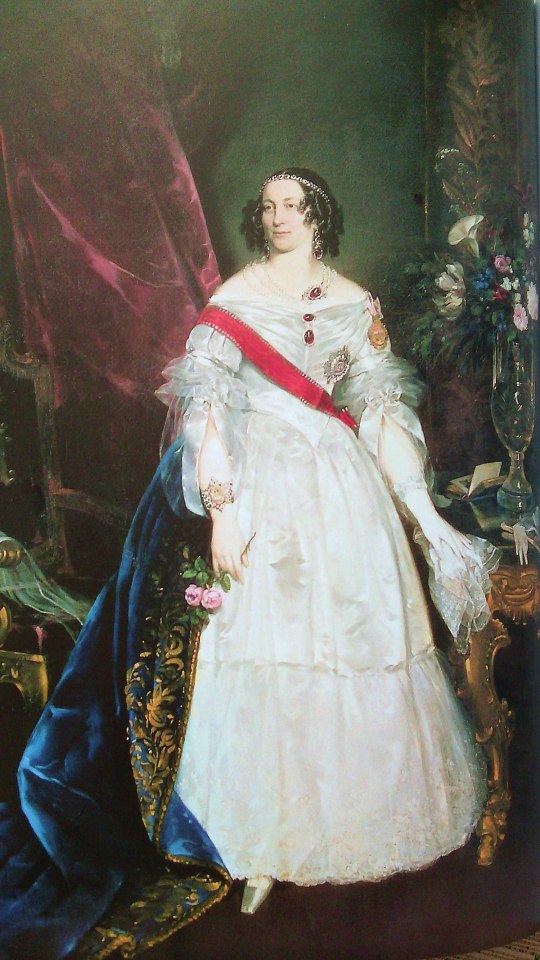
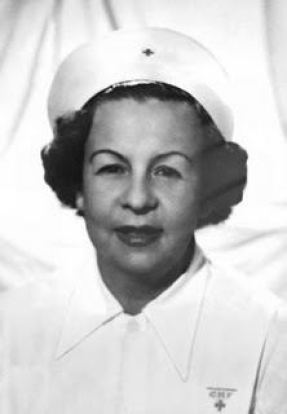
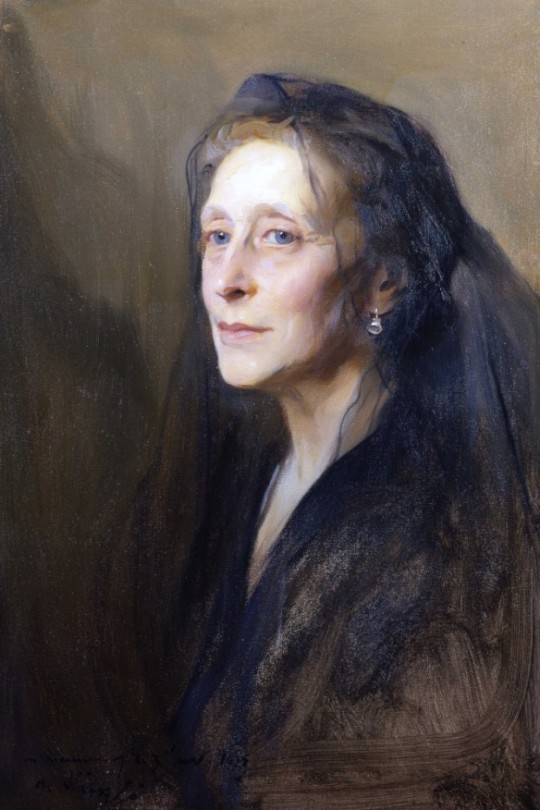
Royal Deaths, 24th September.
768 - Pippin III, the short, King of France.
911 - Louis the child, last Carolingian German King.
1120 - Welf II, Duke of Bavaria.
1143 - Agnes of Germany, daughter of Henry IV, Holy Roman Emperor.
1180 - Manuel I Komnenos, Emperor of the Byzantine Empire.
1228 - Saint Stefan Nemanjic, Grand Prince of Serbia
1230 - Alfonso IX, King of León and Galicia.
1435 - Isabeau of Bavaria, Queen and wife of Charles VI of France, who ruled during her husband's periods of insanity.
1732 - Emperor Reigen, 112th Emperor of Japan.
1812 - Friedrich Karl August, Prince of Waldeck and Pyrmont.
1834 - Pedro I, Emperor of Brazil and King of Portugal.
1860 - Marie of Württemberg, Duchess of Saxe-Coburg and Gotha, second wife and niece of Ernst I, Duke of Saxe-Coburg and Gotha.
1891 - Alexandra of Greece and Denmark, Grand Duchess Alexandra Georgievna of Russia, daughter of King George I of Greece, wife of Grand Duke Paul Alexandrovich of Russia.
1930 - Marie Juliette Louvet, mistress of Prince Louis Il of Monaco, mother of his only child Princess Charlotte of Monaco.
1950 - Princess Victoria of Hesse and by Rhine, Marchioness of Milford Haven, granddaughter of Queen Victoria.
3 notes
·
View notes